Have you heard the one about the two traveling salesmen? Seems that one was named “Boyd”; the other was named “Howard.” Boyd sold hardware; Howard sold shoes. So, naturally one day Boyd and Howard got bored with selling wing nuts and wing tips and decided to try their hand at selling a subdivision.
No joke. That is how the West Side neighborhood of Hi Mount began.
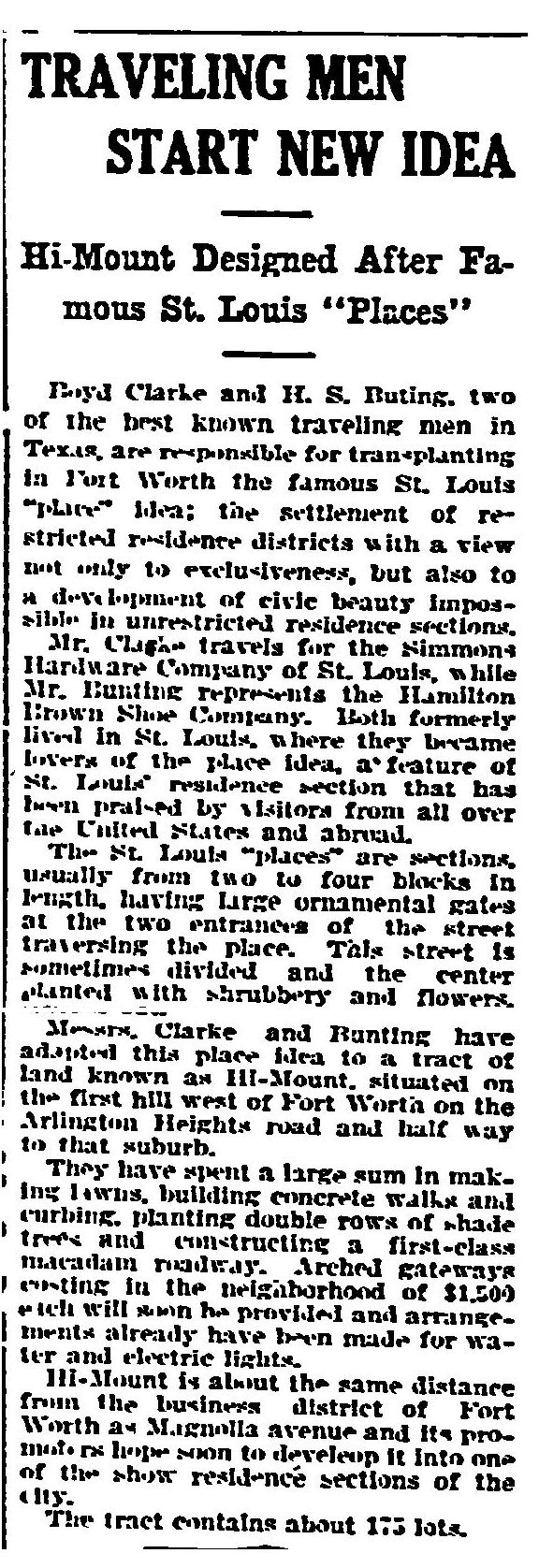 Back in 1906 Boyd Clarke and Howard Bunting developed the “exclusive suburb” of Hi Mount in Arlington Heights, inspired by upscale enclaves such as St. Louis’s Westminster Place and Van de Venter Place, which the two men had seen while living in that city. (Hamilton-Brown Shoe Company was part of Brown Shoe Company, as in Buster Brown and his dog Tige.)
Back in 1906 Boyd Clarke and Howard Bunting developed the “exclusive suburb” of Hi Mount in Arlington Heights, inspired by upscale enclaves such as St. Louis’s Westminster Place and Van de Venter Place, which the two men had seen while living in that city. (Hamilton-Brown Shoe Company was part of Brown Shoe Company, as in Buster Brown and his dog Tige.)
 Bunting and Clarke began the groundwork for Hi Mount in 1905. For example, on November 9, 1905 the Fort Worth Telegram reported that Bunting and his wife sold fifteen acres to the Hi-Mount Land Company ($10,000 would be $255,000 today).
Bunting and Clarke began the groundwork for Hi Mount in 1905. For example, on November 9, 1905 the Fort Worth Telegram reported that Bunting and his wife sold fifteen acres to the Hi-Mount Land Company ($10,000 would be $255,000 today).
 This Telegram ad of 1907 emphasizes the elevation of the new subdivision, boasting that Hi Mount was higher than the just-completed Flatiron Building, which topped out at a vertiginous seven stories. Of course, in the cosmic scheme of things Fort Worth is—let’s face it—relatively level. Maybe that’s why we have tended to name any subdivision possessed of the slightest elevation in a way that calls attention to that elevation. Hence, we have parts of town named “Arlington Heights,” “Polytechnic Heights,” “Sycamore Heights,” “Washington Heights,” “Fostepco Heights,” “Bowie Heights,” “Mistletoe Heights,” “South Hemphill Heights,” “Brooklyn Heights,” “Frisco Heights,” “Eastern Hills,” “Western Hills,” “White Lake Hills,” “South Hills,” “Colonial Hills,” “Park Hill.” (You can get a nosebleed just reading a city map.)
This Telegram ad of 1907 emphasizes the elevation of the new subdivision, boasting that Hi Mount was higher than the just-completed Flatiron Building, which topped out at a vertiginous seven stories. Of course, in the cosmic scheme of things Fort Worth is—let’s face it—relatively level. Maybe that’s why we have tended to name any subdivision possessed of the slightest elevation in a way that calls attention to that elevation. Hence, we have parts of town named “Arlington Heights,” “Polytechnic Heights,” “Sycamore Heights,” “Washington Heights,” “Fostepco Heights,” “Bowie Heights,” “Mistletoe Heights,” “South Hemphill Heights,” “Brooklyn Heights,” “Frisco Heights,” “Eastern Hills,” “Western Hills,” “White Lake Hills,” “South Hills,” “Colonial Hills,” “Park Hill.” (You can get a nosebleed just reading a city map.)
Salesmen Clarke and Bunting decided to give their subdivision, situated on a slope west of Fort Worth, a double-scoop connotation of altitude: both Hi and Mount.
 The Telegram on July 22 sprinkled superlatives throughout its coverage of the “restricted” (to white people), “aristocratic settlement”: “beautiful,” “elegantly situated,” “class by itself,” “picturesque.” The “exclusive suburb” would be “thrown open” to the public on July 22, 1906.
The Telegram on July 22 sprinkled superlatives throughout its coverage of the “restricted” (to white people), “aristocratic settlement”: “beautiful,” “elegantly situated,” “class by itself,” “picturesque.” The “exclusive suburb” would be “thrown open” to the public on July 22, 1906.
The bottom clip boasts that Hi Mount was located “above the dust and noise and bad odors of the business section.”
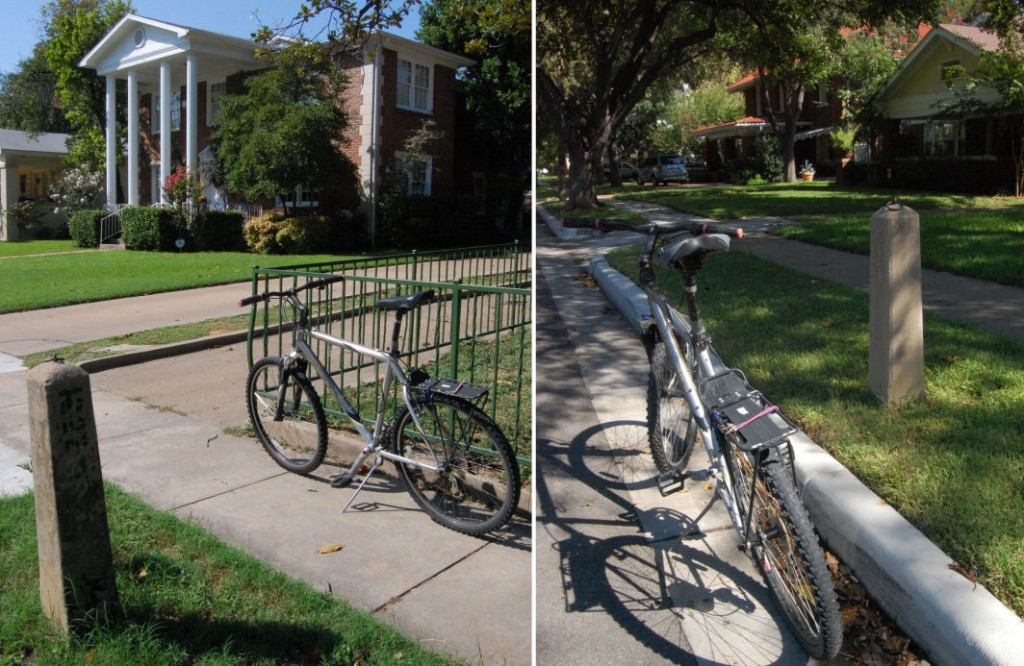 Clarke and Bunting began their development at a time when most people still traveled by horse and buggy. (Photo shows two surviving hitching posts in Hi Mount.) Early in the twentieth century, features that today we take for granted—indoor plumbing, paved streets, concrete sidewalks, electric lighting—were still selling points in real estate advertising.
Clarke and Bunting began their development at a time when most people still traveled by horse and buggy. (Photo shows two surviving hitching posts in Hi Mount.) Early in the twentieth century, features that today we take for granted—indoor plumbing, paved streets, concrete sidewalks, electric lighting—were still selling points in real estate advertising.
The original Hi Mount was north of Camp Bowie Boulevard between River Crest Country Club and today’s UNT Health Science Center. But eventually sections of Arlington Heights south of Camp Bowie also were labeled “Hi Mount.”
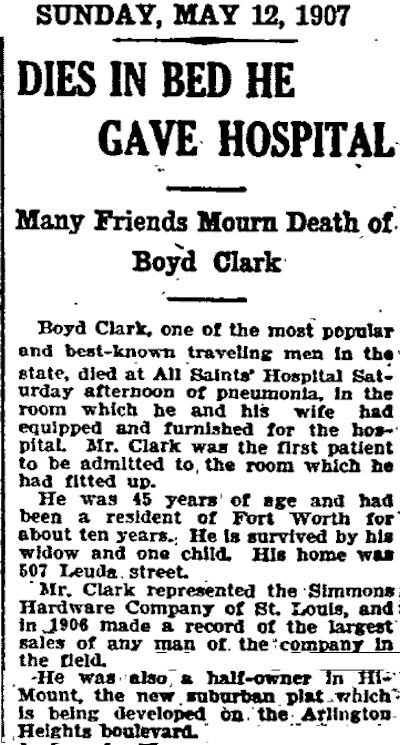 Hi Mount was still in the early stage of development when Boyd Clarke died in 1907 in a room he had endowed at All Saints Hospital. The hospital had been open only six months.
Hi Mount was still in the early stage of development when Boyd Clarke died in 1907 in a room he had endowed at All Saints Hospital. The hospital had been open only six months.
 Clarke is buried in Oakwood Cemetery.
Clarke is buried in Oakwood Cemetery.
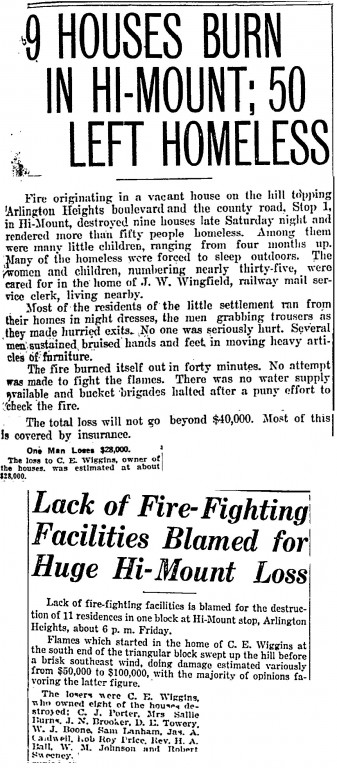 Hi Mount suffered a few setbacks early on. Fire destroyed houses in Hi Mount in 1914 and 1922. Note that in both fires most of the houses belonged to the same man: C. E. Wiggins.
Hi Mount suffered a few setbacks early on. Fire destroyed houses in Hi Mount in 1914 and 1922. Note that in both fires most of the houses belonged to the same man: C. E. Wiggins.
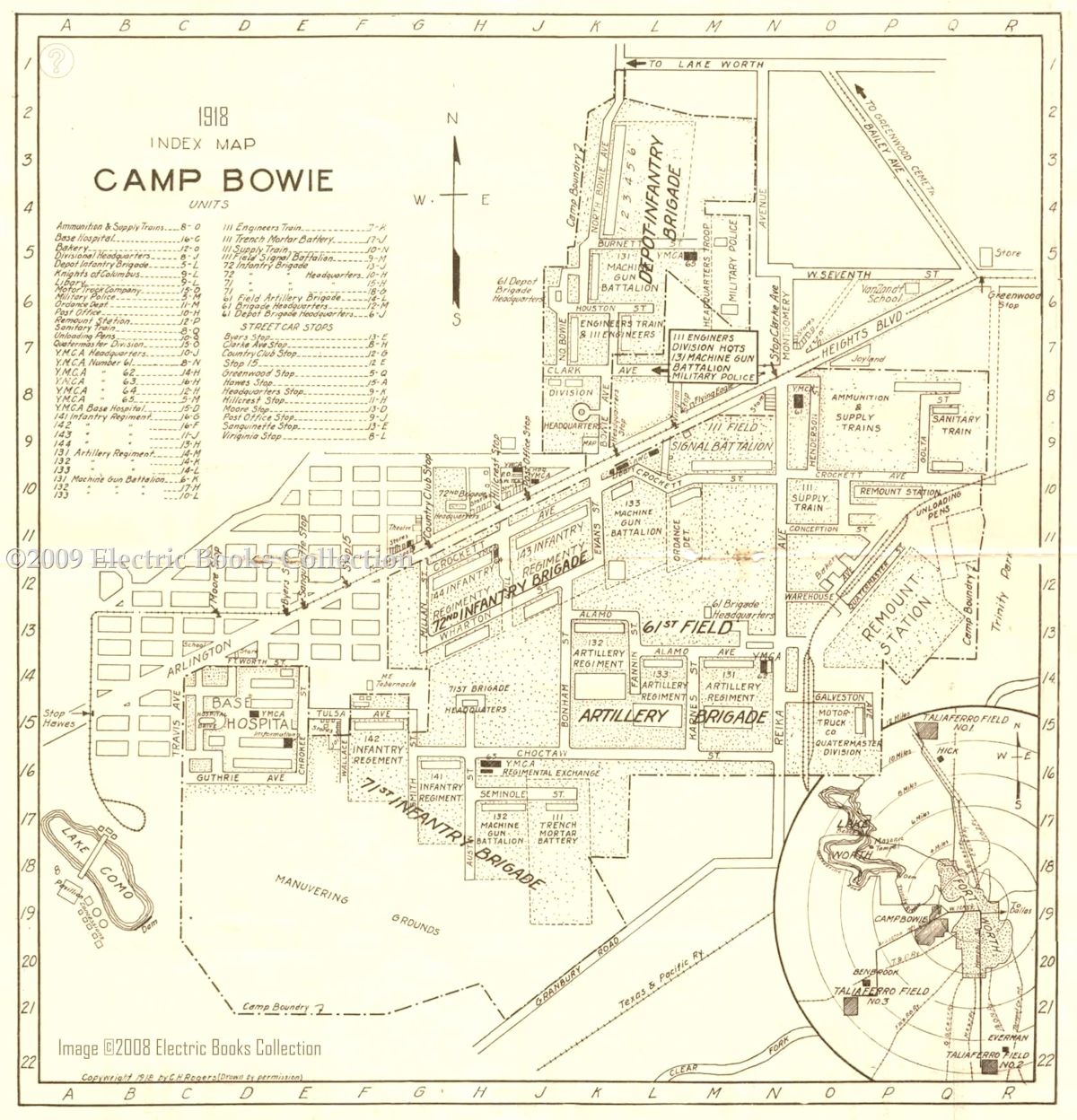 After the United States entered World War I, development of Hi Mount, like that of much of the rest of Arlington Heights, was interrupted by construction of the Army’s Camp Bowie, which turned Arlington Heights into a crazy quilt of military and civilian real estate. Thousands of men of the Army’s 36th Infantry Division became temporary residents of Hi Mount.
After the United States entered World War I, development of Hi Mount, like that of much of the rest of Arlington Heights, was interrupted by construction of the Army’s Camp Bowie, which turned Arlington Heights into a crazy quilt of military and civilian real estate. Thousands of men of the Army’s 36th Infantry Division became temporary residents of Hi Mount.
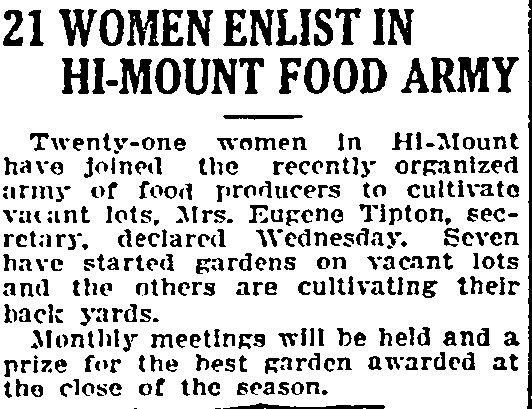 Hi Mount women helped in the war effort by planting vegetable gardens on vacant lots. After the war ended, those gardens and other vacant lots began to grow houses. The Army vacated Camp Bowie and left the base’s vast infrastructure intact. This infrastructure gave builders a head start when development of Arlington Heights resumed.
Hi Mount women helped in the war effort by planting vegetable gardens on vacant lots. After the war ended, those gardens and other vacant lots began to grow houses. The Army vacated Camp Bowie and left the base’s vast infrastructure intact. This infrastructure gave builders a head start when development of Arlington Heights resumed.
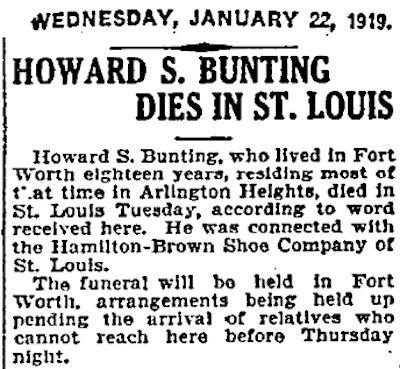 In 1919, soon after the war ended, Howard Bunting died.
In 1919, soon after the war ended, Howard Bunting died.
 He, too, is buried in Oakwood Cemetery.
He, too, is buried in Oakwood Cemetery.
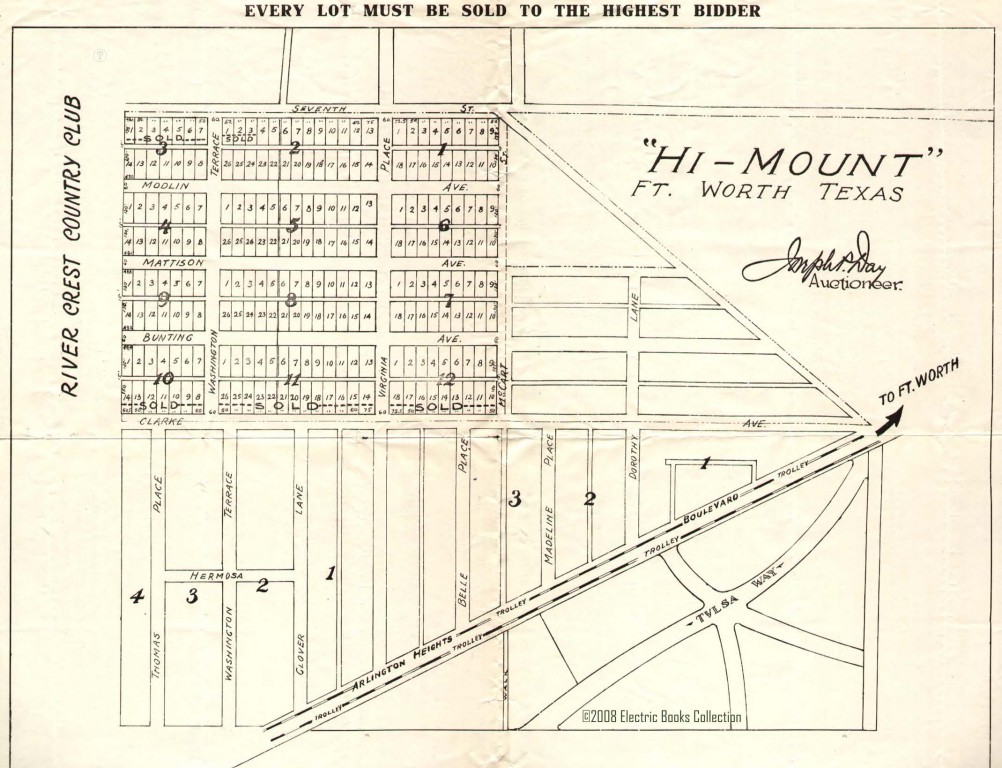 After the camp was vacated, much of Arlington Heights was replatted, streets were renamed. Hi Mount was still sparsely developed in 1921, when lots were sold at auction.
After the camp was vacated, much of Arlington Heights was replatted, streets were renamed. Hi Mount was still sparsely developed in 1921, when lots were sold at auction.
Note streets named for Bunting and real estate agent Delbert Modlin. (Plat from Pete Charlton’s “The Lost Antique Maps of Texas: Fort Worth & Tarrant County, Volume 2” CD.)
 Belle Place and Virginia Place were surely named for Bunting’s daughters.
Belle Place and Virginia Place were surely named for Bunting’s daughters.
 After the 1922 “greater Fort Worth” annexation vote, in which Fort Worth gobbled up suburbs in all directions, including Arlington Heights, Hi Mount received more capital improvements.
After the 1922 “greater Fort Worth” annexation vote, in which Fort Worth gobbled up suburbs in all directions, including Arlington Heights, Hi Mount received more capital improvements.
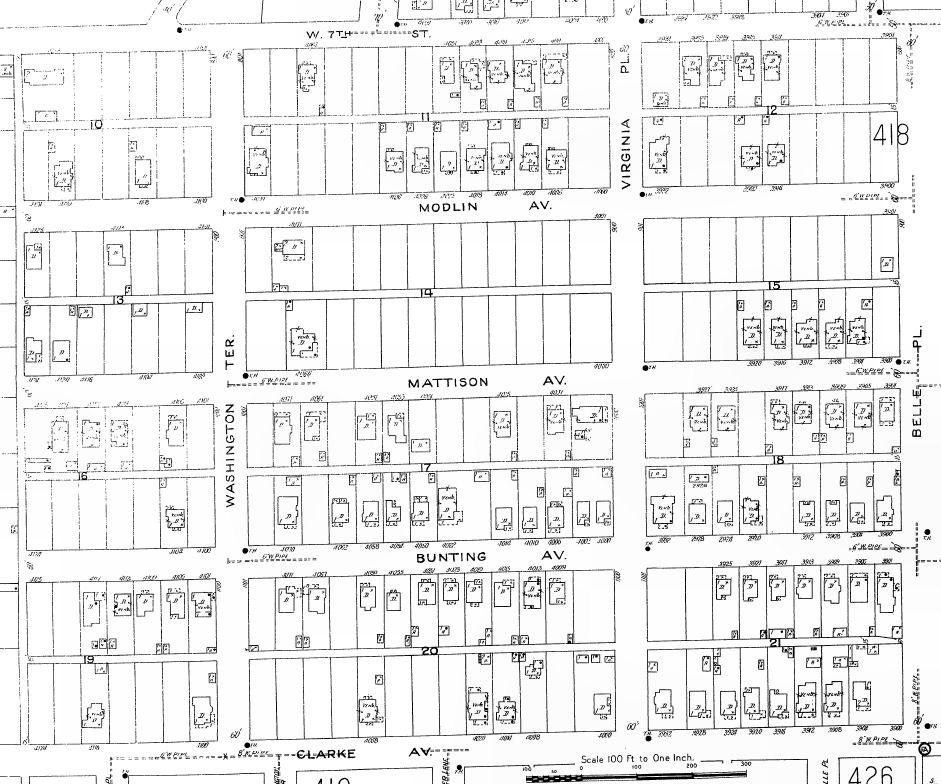 In the 1920s the west Texas oil boom created jobs and a need for more housing. Camp Bowie Boulevard was Fort Worth’s connection to west Texas. As a result of these factors, the population of Hi Mount increased. By 1926 the map of Hi Mount was filling in.
In the 1920s the west Texas oil boom created jobs and a need for more housing. Camp Bowie Boulevard was Fort Worth’s connection to west Texas. As a result of these factors, the population of Hi Mount increased. By 1926 the map of Hi Mount was filling in.






I have a very old picture of gate to Hi Mount entrance to Belle Place. Horse and carriages are in photo.
I didn’t want to toss if it is part of history. Please send me a way to copy the picture and/or original to send to you.
My parents were from Ennis and Waxahachie.
Thanks
Thank you for visiting the site. Unfortunately the author, Mike Nichols, passed away and we are working on how best to preserve this informative site.
I so enjoyed this article. Thanks. Howard S Bunting is my great grandfather. Belle Bunting was his daughter and my grandmother. I now live in Paducah Ky.
Thank you. I hope there is always an intersection in Hi Mount that reminds us of the Bunting role in West Side history.
Dear Ms.Shumaker. HS Bunting was my great-grandfather. My name is William W. Bunting III. I believe that my grandfather was your grandmother’s brother.
It was a joy to read this story and to see your post.
Sincerely,
William W. Bunting III
Thanks for the look at Hi Mount. I grew up on Lot 26 at Washington Ter & Bunting. We were the second family to live in the house. It was built around 1942. Since my mom passed in 1999 the property was sold even though I tried to keep it in the family. The house was demolished and a huge house built. I have the abstract of Title for the property. Again thanks for the retro-view….Dale
It’s a beautiful neighborhood. Two more Hi Mount posts coming. I have the abstract of my childhood home on the East Side. Fascinating document.